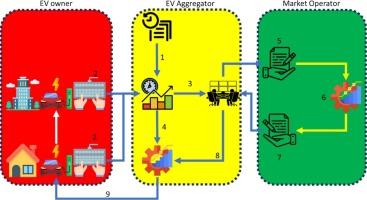通过电动汽车聚合器利用能源套利利益的综合框架
IF 8.9
2区 工程技术
Q1 ENERGY & FUELS
引用次数: 0
摘要
本文提出了电动汽车聚合器作为能源套利实体运行的综合框架,旨在为电动汽车所有者提供稳定的收入流,同时通过最大化系统的负载系数(LF)来减少电网压力。该框架集成了空间电动汽车行为分析、基于机器学习的电力需求和价格预测以及两阶段优化过程。第一阶段利用混合整数线性规划(MILP)来优化充放电计划,从而最大化电动汽车车主的收入。第二阶段采用基于梯度的顺序二次规划(GD-SQP)来优化参与电动汽车的数量,以实现电网效益。该模型基于澳大利亚昆士兰州的真实数据,包括来自旅行调查的电动汽车移动数据和来自国家电力市场的历史5分钟分辨率数据。预测性能表明,精细树算法(FTA)对电力需求预测效果最好,而集成袋树算法(EBTA)对电价预测效果最好。在IEEE 9总线和39总线系统上的仿真结果验证了该框架的性能。在9总线系统中,在H-EV过度优化情况下,LF提高了6.08%。相比之下,HW-EV方案由于收入优化调度与系统目标之间的不一致而降低了LF。相比之下,39总线的结果表明,HW-EV优化可以达到6.2%的LF改进,突出了网格拓扑和空间灵活性的影响。该框架还实现了高达6.08%的传输损耗减少,并带来了额外的好处,包括高峰负荷转移、延迟基础设施投资和增加聚合器的收入。一个重要的发现是,由于两阶段优化中固有的权衡,较长的电动汽车连接持续时间(如HW-EV)并不能保证更好的电网性能。这些结果证实,必须谨慎管理电动汽车的参与,以在经济和技术目标之间取得平衡。总体而言,本研究表明,在预测和双重优化的支持下,数据驱动的电动汽车协调可以在未来的智能能源系统中为电动汽车车主和电网带来巨大的利益。本文章由计算机程序翻译,如有差异,请以英文原文为准。

A comprehensive framework for harnessing energy arbitrage benefits through an electric vehicle aggregator
This paper proposes a comprehensive framework for an EV aggregator to operate as an energy arbitrage entity, aiming to provide a steady income stream to EV owners while reducing grid stress by maximising the system's Load Factor (LF). The framework integrates spatial EV behaviour analysis, machine learning-based forecasting of electricity demand and prices, and a two-stage optimisation process. The first stage utilises Mixed-Integer Linear Programming (MILP) to optimise charging and discharging schedules, thereby maximising EV owner revenue. The second stage employs Gradient-Based Sequential Quadratic Programming (GD-SQP) to optimise the number of participating EVs for grid benefits. The model is built on real-world data from Queensland, Australia, including EV mobility derived from travel surveys and historical 5-minute resolution data from the National Electricity Market. Forecasting performance indicates that the Fine Tree Algorithm (FTA) is most effective for electricity demand prediction, while the Ensemble Bagged Tree Algorithm (EBTA) performs best for price forecasting. Simulation results on the IEEE 9-bus and 39-bus systems validate the framework's performance. In the 9-bus system, LF improves by up to 6.08 % in the H-EV Over-optimum scenario. In contrast, HW-EV scenarios yield reduced LF due to misalignment between revenue-optimised dispatch and system objectives. In contrast, the 39-bus results show that HW-EV Optimum can achieve up to 6.2 % LF improvement, highlighting the influence of grid topology and spatial flexibility. The framework also achieves up to 6.08 % reduction in transmission loss, with additional benefits including peak load shifting, deferred infrastructure investment, and increased revenue for aggregators. An important finding is that longer EV connection durations, as in HW-EV cases, do not guarantee better grid performance due to a trade-off inherent in the two-stage optimisation. These results confirm that EV participation must be carefully managed to strike a balance between economic and technical objectives. Overall, this study demonstrates that data-driven EV coordination, supported by forecasting and dual optimisation, can unlock substantial benefits for both EV owners and the power grid in future smart energy systems.
求助全文
通过发布文献求助,成功后即可免费获取论文全文。
去求助
来源期刊

Journal of energy storage
Energy-Renewable Energy, Sustainability and the Environment
CiteScore
11.80
自引率
24.50%
发文量
2262
审稿时长
69 days
期刊介绍:
Journal of energy storage focusses on all aspects of energy storage, in particular systems integration, electric grid integration, modelling and analysis, novel energy storage technologies, sizing and management strategies, business models for operation of storage systems and energy storage developments worldwide.
 求助内容:
求助内容: 应助结果提醒方式:
应助结果提醒方式:


